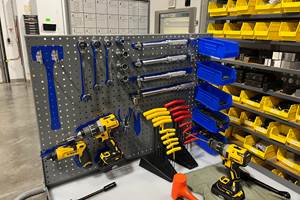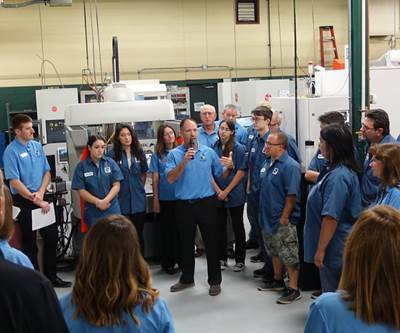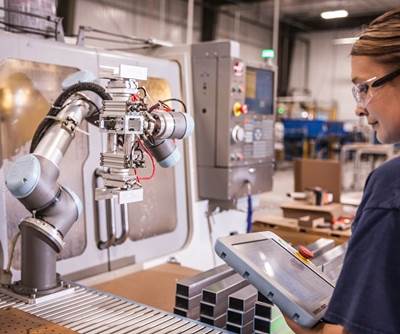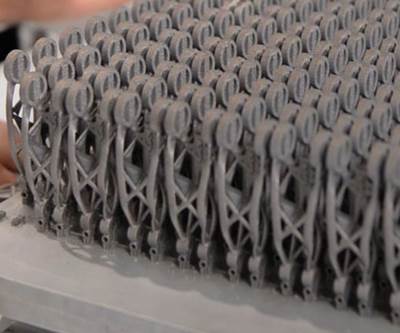3 Major Trends in Manufacturing (And They All Begin with “A”)
Peter Zelinski sees three long-term trends that continue to reshape manufacturing.
Share







.png;maxWidth=45)
DMG MORI - Cincinnati
Featured Content
View More
Autodesk, Inc.
Featured Content
View More
Hwacheon Machinery America, Inc.
Featured Content
View More
People ask me what's going on in manufacturing — what I'm seeing in my travels to manufacturing facilities and what I'm learning in my conversations with the people who lead them. In broad terms, my answer doesn’t change. It’s been the same for several years now and I expect it will be the same for several years to come. In manufacturing, I see three big, major, long-term trends: three big changes that continue to reshape manufacturing. And as it happens, all three of them begin with the same letter. They are:
1. Automation
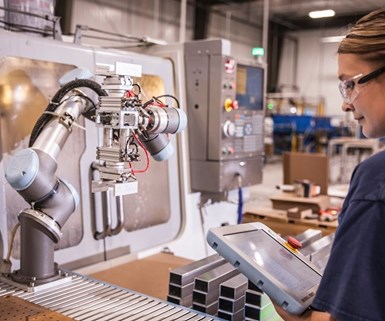
When you think of automation, you might think of “robot,” but that’s only part of it. (Photo courtesy of Alexandria Industries.)
One major trend is the ongoing adoption, development and embrace of manufacturing machines and systems that can do more with fewer humans involved. When you read the word “automation,” you probably think, “robot.” That’s part of it. But automation also refers to machines that are increasingly sophisticated and effective at performing a series of operations and/or adding a significant amount of value in a single handling of a part. And when we talk about “data-driven manufacturing” and “Industry 4.0,” ultimately we are talking about automation here as well, in the form of system-level automation aimed at sensing and identifying process changes and making appropriate responses that once would have required human intervention. A growing number of manufacturers today, including small ones, are mastering automation sufficiently to realize reliable lights-out processes that perform production at night while no employees are present. The companies able to do this have essentially found an outsource supplier within their own building, as they shift some work formerly done in the staffed daytime hours into the unattended hours at night.
2. Additive Manufacturing
The fastest moving arena of manufacturing right now, additive manufacturing — making parts through 3D printing — continues to advance and continues to realize possibilities that only a few years ago would have seemed beyond the capabilities of this set of processes. The most important development in additive manufacturing right now is its progress into becoming an option not just for end-use production parts, but for end-use production parts at quantities that (for some products) represent full-scale production. Additive manufacturing as a means of making parts permits part designs that are impractical or impossible with conventional manufacturing methods. Meanwhile, additive manufacturing as a means of making parts at production scale will transform and simplify supply chains by allowing much more of production to be performed very close to when and where the part is needed.
3. Atmosphere

Shops like Westminster Tool are reaping the benefits of putting effort into changing their company culture.
The very air of manufacturing is changing as people with different outlooks come into it, and these people are leading and influencing the development of different types of manufacturing organizations. I am part of Generation X. People my age were discouraged from seeing manufacturing as the worthy and challenging work it is. As a result, manufacturing has largely skipped a generation, as Boomer-age professionals with a career’s worth of experience in skilled manufacturing work are replaced by Millennial-age newcomers who frequently lack formal manufacturing training, but who are enthusiastic and ready to embrace the work of manufacturing without any of the resistance to it my generation carried. Employers able to make use of this new and different crop of talent have done so by systemizing their manufacturing processes, systemizing training and skill-development opportunities within these processes, and in many cases changing the very culture of their businesses in order to transition from relying on skilled craftsmen working independently to relying on attentive novices working in collaboration.
We Cover All 3
I am privileged to lead the editorial efforts of two Gardner Business Media brands: Modern Machine Shop is our longest-established brand, and Additive Manufacturing (AM) is our youngest brand. Established in 2012, it focuses on trend No. 2 above. Under the AM brand, we find and inform a manufacturing audience interested in industrial 3D printing through a print magazine, an annual conference and a new video series called “The Cool Parts Show.” Modern Machine Shop, published since Gardner’s founding in 1928, focuses on CNC machining technology and the shops and plants investing in it. MMS employs a team of writers who are busy finding, visiting and telling the stories of manufacturers thriving with machining technology and embracing new ideas about how to use it, and as we do, we find ourselves again and again encountering and exploring all three of the major trends above.
Related Content
Translating a Prototyping Mindset to Production
The experimental mindset that benefited BDE Manufacturing Technologies as a prototype job shop has given it an adaptable edge as a production facility.
Read MoreLean Approach to Automated Machine Tending Delivers Quicker Paths to Success
Almost any shop can automate at least some of its production, even in low-volume, high-mix applications. The key to getting started is finding the simplest solutions that fit your requirements. It helps to work with an automation partner that understands your needs.
Read MoreCutting Part Programming Times Through AI
CAM Assist cuts repetition from part programming — early users say it cuts tribal knowledge and could be a useful tool for training new programmers.
Read MoreCNC Machine Shop Honored for Automation, Machine Monitoring
From cobots to machine monitoring, this Top Shop honoree shows that machining technology is about more than the machine tool.
Read MoreRead Next
For This Mold Shop, the Key to Closing the Skills Gap is Emotional Intelligence
Thanks to a culture change founded on a commitment to emotional intelligence, this mold supplier solved its skilled labor problem and increased throughput per employee.
Read MoreIncreasing Employee Output Through Automation: Here is What We Found in 7 Recent Shop Visits
Modern Machine Shop editors routinely visit machining facilities to report on shops that are succeeding. Here is what our editors found on seven recent shop visits, all related to using labor more efficiently.
Read MoreProduction Additive Manufacturing Is Already Happening
3D printing has become commonplace in machine shops as a way of manufacturing jigs, fixtures and other tooling. But where is it being used for production?
Read More









.png;maxWidth=150)





























